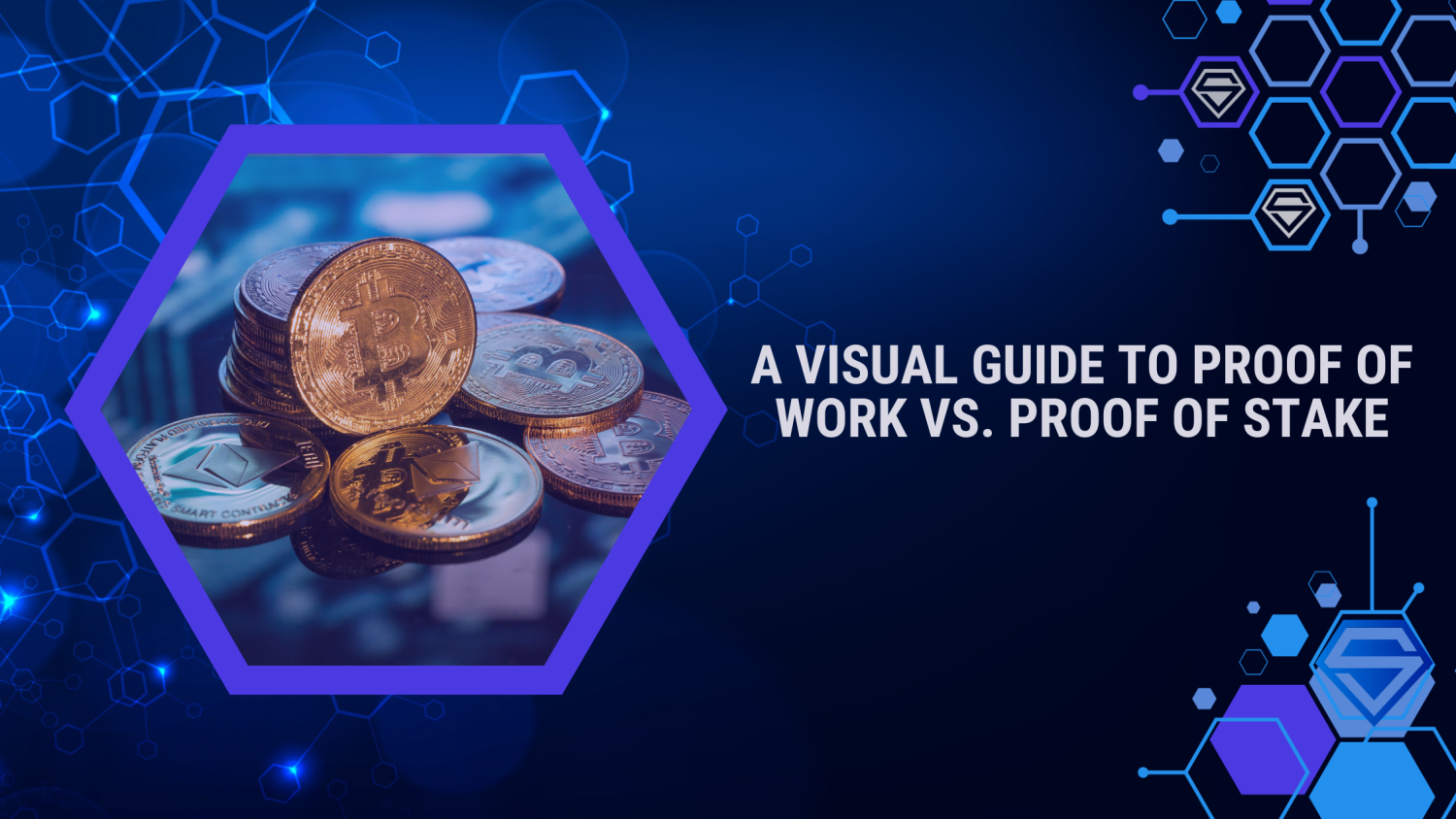
25. October, 2023
Crypto Clash: Proof of Work vs. Proof of Stake – What’s the Difference?
Are you ready to dive into the epic showdown of blockchain technology? It’s time to put on your virtual boxing gloves because we’re about to explore one of the most captivating debates in the crypto world – Proof of Work (PoW) vs. Proof of Stake (PoS).
Understanding the fundamental differences and intricacies between these two consensus mechanisms has never been more crucial as the cryptocurrency universe expands at warp speed. Imagine it as the classic battle between brains and brawn, with each side vying for the ultimate supremacy in the digital domain.
So, stick with us as we embark on this thrilling journey of discovery, whether you’re a seasoned crypto enthusiast, a curious newcomer, or someone who enjoys a good techy showdown. Let’s get ready to rumble!
The Battle for Consensus: Proof of Work vs. Proof of Stake
Cryptocurrency enthusiasts often find themselves torn between two major questions:
- How can we secure a blockchain network in a trustless environment?
- What is the most energy-efficient and cost-effective way to validate transactions on the blockchain?
PoW and PoS serve as solutions to these pressing concerns, but they do so in radically different ways.
Proof of Work as the Traditional Workhorse
Proof of Work (PoW) is the foundational pillar of security and trust. It’s the mechanism that underpins the essence of cryptocurrencies like Bitcoin, ensuring the integrity of transactions and the impenetrable fortification of the network.
At its core, PoW harnesses the collective computational power of miners who embark on a journey of puzzle-solving. These puzzles are not your run-of-the-mill crosswords but intricate cryptography that demands unwavering dedication and considerable computational muscle. For miners, PoW is a commitment that goes beyond mere software expertise. It necessitates a tangible investment in high-end hardware, graphics cards, and processing power. The more powerful the hardware, the better one’s chances of cracking the cryptographic puzzles. This relentless pursuit of computational excellence ensures the blockchain remains a sanctuary of trust and reliability.
While this method ensures security and immutability, it’s not without its drawbacks:
Energy Consumption
Yet, PoW isn’t without its controversies. Perhaps its most notable Achilles’ heel is its voracious appetite for energy. The energy consumption of PoW networks has raised eyebrows on a global scale.
Critics argue that the substantial power required for mining is detrimental to the environment, especially considering the increasing popularity of cryptocurrencies.
Centralization Risks
Another concern that looms over PoW is the risk of centralization. In the early days, individual miners could mine Bitcoin with a standard PC, but over time, the landscape evolved. Large mining pools emerged, where multiple miners combined their computational power.
While this aggregation can be efficient, it raises concerns about centralization. The more control these mining pools amass, the greater the potential for a concentration of power, which contradicts the decentralized ethos of blockchain technology.
Proof of Stake: A Paradigm Shift
Proof of Stake (PoS) emerges as a revolutionary force, a paradigm shift that challenges the traditional norms of securing and validating transactions. PoS, unlike its older sibling PoW, ushers in a new era of blockchain consensus.
In the PoS ecosystem, trust isn’t mined through computational power and puzzle-solving but rather earned through the currency of the digital realm. Validators, the key players in PoS, are chosen not based on their computational might but rather the amount of cryptocurrency they possess and are willing to “stake” as collateral. This is a fundamental departure from the energy-intensive PoW model.
It’s akin to a digital oath of allegiance, where your financial commitment acts as a testament to your trustworthiness
However, PoS has its own set of advantages and disadvantages:
Energy Efficiency
One of the most remarkable hallmarks of PoS is its commitment to environmental sustainability. By eschewing the power-hungry puzzle-solving aspect, PoS networks are notably more energy-efficient.
This environmentally conscious approach has been welcomed by a world increasingly concerned about the ecological footprint of cryptocurrencies. It represents a step forward in the quest for sustainable blockchain solutions.
Wealth Concentration
However, PoS isn’t without its own set of complexities. Critics point to the risk of wealth centralization, a concern that emerges when those with more funds have more influence. In a PoS network, the concentration of power can stem from the unequal distribution of cryptocurrency, potentially posing challenges to the decentralized ethos of blockchain.
A Side-By-Side Comparison
Now, let’s break down the differences between PoW and PoS:
1. Security and Immutability
Proof of Work (PoW):
PoW leans on computational power as the bedrock of its security framework. Miners invest their resources and expertise in solving intricate cryptographic puzzles. This intricate puzzle-solving process ensures the utmost security and immutability of the blockchain, making it an ironclad fortress against fraudulent activities.
Proof of Stake (PoS):
In contrast, PoS takes a different approach by emphasizing financial investment as a security measure. Validators are selected based on the amount of cryptocurrency they are willing to “stake” as collateral, underscoring their vested interest in maintaining the integrity of the network. This approach, while innovative, may be perceived as less secure when compared to the computational prowess of PoW.
2. Energy Efficiency
Proof of Work (PoW):
The reputation of PoW for its energy consumption precedes it. The energy-intensive puzzle-solving activities undertaken by miners have raised global concerns about sustainability. The quest for mining rewards consumes significant electricity, which contributes to environmental challenges.
Proof of Stake (PoS):
PoS, on the other hand, champions energy efficiency. By eliminating the computational puzzle-solving component, PoS dramatically reduces the energy footprint of blockchain networks. This eco-friendly approach aligns with the growing demand for sustainable solutions in the digital realm.
3. Centralization
Proof of Work (PoW):
PoW has grappled with concerns surrounding centralization. Over time, the landscape of mining has evolved, giving rise to large mining pools where multiple miners combine their computational power. This aggregation has sparked worries about centralization and the concentration of control in the hands of a few.
Proof of Stake (PoS):
In the PoS paradigm, concerns shift from computational centralization to wealth centralization. The more cryptocurrency one holds and is willing to stake, the greater their influence in the network. This can lead to imbalances where a select few wield significant power, potentially challenging the decentralization ethos.
4. Accessibility
Proof of Work (PoW)
Accessibility to PoW is relatively straightforward. Anyone equipped with the right hardware and technical know-how can participate in the mining process. This inclusive approach has been one of the strengths of PoW, allowing a broad range of individuals to contribute to the network.
Proof of Stake (PoS)
In contrast, PoS introduces a more exclusive dimension. Participation in PoS networks is contingent on one’s cryptocurrency holdings and willingness to stake them. This makes PoS more accessible to individuals with substantial cryptocurrency investments, potentially creating a barrier to entry for others.
Conclusion: Making Your Choice
The choice between PoW and PoS ultimately depends on your priorities and values. PoW’s robust security and decentralization come at an environmental cost, while PoS offers energy efficiency at the potential risk of wealth centralization.
As the crypto landscape evolves, it’s essential to stay informed and adapt to the changes. Whether you lean toward Proof of Work or Proof of Stake, you’re now equipped with the knowledge to make an informed decision.


